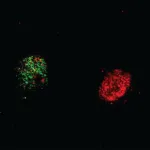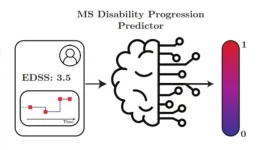(Press-News.org) Researchers from North Carolina State University have developed an array that assesses methylation levels of genes located in imprint control regions (ICRs) within the human genome. The array represents a cost-effective, efficient method for exploring potential links between environmental exposures and epigenetic dysregulation during the early developmental origins of diseases and behavioral disorders.
ICRs regulate the expression of imprinted genes – genes where only one parental copy of the gene is active, while the other copy is silenced early in development. Imprinted genes are of special interest to epidemiologists, geneticists, and toxicologists who study the connections between environmental influences and disease because the methylation marks that control their expression are susceptible to environmental influences.
These DNA methylation modifications can be stable throughout the life of the affected individual and may even be passed on to their children. This is of particular interest in epigenetics, which is the study of heritable changes in gene expression in the absence of DNA sequence changes.
“Methylation – whether a gene is ‘off’ or ‘on’ – is the easiest thing to look at when you’re investigating epigenetic effects,” says Cathrine Hoyo, professor of biological sciences at NC State and co-corresponding author of the work. “It serves as a jumping off point for figuring out relationships between the environment and gene expression.”
While methylation arrays do exist for investigating gene expression, the ones most commonly used do not include probes specific to ICRs. Instead, scientists interested in imprinted gene regulation must sequence the entire genome of a subject, which is costly, time-consuming and impractical in large population studies.
The new array contains 22,000 fluorescent probes that are specific to 1,000 of the known 1,488 ICRs in the human genome. The probes are short DNA sequences that target specific methylation sites within these ICRs, with alternate probes binding the methylated and unmethylated versions. The alternate probes for each target site have different fluorescent signals, so that the relative amount of each probe bound can be measured, and the methylation level for each site determined from the ratio of the specific probes.
As proof of concept, the research team used DNA from a set of Alzheimer’s patients to compare ICR methylation data from the array data to the methylation results obtained by whole genome sequencing, and found a significant correlation between the two methods. Most notably for clinical application, the results were complete after one week, as compared to potentially months required for interpreting full genomes.
“In large studies we have to screen the participants,” Hoyo says. “If there are 1,000 people in a study, it simply isn’t possible to do that many complete genomic sequences in a timely and cost-effective way. It is especially wasteful when you consider that we are only interested in 22,000 sites out of millions in the genome.
“This array does the screening for us – it looks only at the sites of interest and allows us to focus time and energy on full sequencing only when necessary. Essentially it sifts the wheat from the chaff so we can focus only on the ICRs that may be involved in disease.”
The work appears in Epigenetics Communications and was supported by the National Institutes of Health under grant numbers R01ES093351, R01HD098857, R01MD011746, and R21HD093351, and by funding from NC State’s Center for Human Health and the Environment. The technology has been licensed by TruDiagnostic, Inc. Ryan Smith from TruDiagnostic is co-corresponding author. Other co-authors include first author Natalia Carreras-Gallo, Varun B. Dwaraka, and Tavis L. Mendez from TruDiagnostic; Dereje D. Jima, David A. Skaar, Antonio Planchart and Randy L. Jirtle from NC State University; and Wanding Zhou from the University of Pennsylvania.
-peake-
Note to editors: An abstract follows.
“Creation and validation of the first infinium DNA methylation array for the human imprintome”
DOI: 10.1186/s43682-024-00028-6
Authors: Dereje D. Jima, David A. Skaar, Antonio Planchart, Randy L. Jirtle, Cathrine Hoyo, North Carolina State University; Wanding Zhou, University of Pennsylvania; Ryan Smith, Natalia Carreras-Gallo, Varun B. Dwaraka, Tavis L. Mendez, TruDiagnostic, Inc.
Published: July 11, 2024 in Epigenetics Communications
Abstract:
Background: Differentially methylated imprint control regions (ICRs) regulate the monoallelic expression of imprinted genes. Their epigenetic dysregulation by environmental exposures throughout life results in the formation of common chronic diseases. Unfortunately, existing Infinium methylation arrays lack the ability to profile these regions adequately. Whole genome bisulfite sequencing (WGBS) is the unique method able to profile the ICRs. However, it is very expensive and it requires not only a high coverage, but it is also computationally intensive to assess these regions.
Findings: To address this deficiency, we developed a custom methylation array containing 22,819 probes. Among them, 10,438 are CG probes targeting unique CpG sites, with 9,757 probes successfully mapping to 1,088 out of the 1,488 candidate ICRs recently described. To assess the performance of the array, we created matched samples processed with the Human Imprintome array and WGBS, which is the current standard method for assessing the methylation of the Human Imprintome. We compared the methylation levels from the shared CpG sites, and obtained a mean R2=0.569. We also created matched samples processed with the Human Imprintome array and the Infinium Methylation EPIC v2 array, and obtained a mean R2=0.796. Furthermore, replication experiments demonstrated high reliability (ICC: 0.799–0.945).
Conclusions: Our custom array will be useful for replicable and accurate assessment, mechanistic insight, and targeted investigation of ICRs. This tool should accelerate the discovery of ICRs associated with a wide range of diseases and exposures, and advance our understanding of genomic imprinting and its relevance in development and disease formation throughout the life course.
END
July 25, 2024 — For patients with cervical radiculopathy, posterior foraminotomy provides outcomes comparable to those of the more commonly performed anterior cervical discectomy, reports a randomized clinical trial in The Journal of Bone & Joint Surgery. The journal is published in the Lippincott portfolio by Wolters Kluwer.
"[O]ur findings provide Level-I evidence that posterior surgery is noninferior to anterior surgery with regard to the clinical outcome, with follow-up of two years," according to the new research by Nádia F. Simões de Souza, MD, and Anne E. H. Broekema, MD, ...
When we form a new memory, the brain undergoes physical and functional changes known collectively as a “memory trace”. A memory trace represents the specific patterns of activity and structural modifications of neurons that occur when a memory is formed and later recalled.
But how does the brain “decide” which neurons will be involved in a memory trace? Studies have suggested that the inherent excitability of neurons plays a role, but the currently accepted view of learning has neglected to look inside the command ...
University of Sydney researchers are proposing a new way to curb industrial emissions, by tapping into the “atomic intelligence” of liquid metals to deliver greener and more sustainable chemical reactions.
Despite global efforts towards renewable energy and electrification, chemical production accounts for approximately 10-15 percent of total greenhouse gas emissions. More than 10 percent of the world’s total energy is used in chemical factories, with these numbers rising.
This is due to the large amounts of energy required to cause ...
Rainfall fluctuates more vigorously. Why? Scientists say it's because of us.
Many people around the world have noticed that rainfall is becoming increasingly erratic. Intense downpours are occurring more frequently, while dry periods seem to last longer and become more severe. These changes have raised concerns and prompted scientists to investigate the links between climate change and these unpredictable rainfall patterns.
A new study provides the first systematic observational evidence that human-induced climate change is making rainfall patterns more volatile globally.
Published in the journal Science on July 26, a joint study by the Institute of Atmospheric Physics ...
In this Special Issue of Science, four Reviews and a Policy Forum explore the intersections of science, health, and policy related to the air we breathe, tackling topics including how air pollution is monitored, what impacts it has on human health, how those impacts are felt most by populations with fewer resources, and what changes we can make to the built environment to secure clean air.
In one Review, Wei Huang and colleagues discuss the new air quality guidelines from the World Health Organization (WHO) and related challenges ...
Anthropogenic climate warming has led to increased precipitation variability over much of the globe, according to a new study, which points to several hotspots for this trend. This effect is particularly prominent over Europe, Australia, and eastern North America, say the study’s authors, and is largely driven by increasing atmospheric moistening and decadal-scale changes in atmospheric circulation. As the climate warms, the atmosphere becomes more capable of holding moisture, leading to greater fluctuations between extreme precipitation events and wider swings between wet and dry episodes. Such amplified ...
Specific neurons in the brain’s zona incerta (ZI) play a crucial role in the early social interactions of an infant and its mother, building their bond and reducing stress, according to a new study in mice. Activation of the same neurons in adult mice increased anxiety- and fear-like responses, the study showed. In humans, as in other mammals, infants have an inborn tendency to form an attachment bond with their mothers or caregivers – a bond that plays a crucial role in the infant’s development. This bond helps newborns feel secure and serves as a safety net from which to explore their surroundings, learn, and develop crucial skills and behaviors. However, the neural mechanisms ...
Machine learning models can reliably inform clinicians about the disability progression of multiple sclerosis, according to a new study published this week in the open-access journal PLOS Digital Health by Edward De Brouwer of KU Leuven, Belgium, and colleagues.
Multiple sclerosis (MS) is a chronic progressive autoimmune disease that leads to severe disability over time through a complex pattern of progression, recovery, and relapse. Its global prevalence has increased by more than 30% over the last decade. ...
Novel human lung organoids can form lifelike models for tuberculosis infection, and might be used to test efficacy of anti-TB drugs.
####
Article URL: http://journals.plos.org/plospathogens/article?id=10.1371/journal. ppat.1012295
Article Title: Advances in an In Vitro Tuberculosis Infection Model Using Human Lung Organoids for Host-Directed Therapies
Author Countries: Republic of Korea
Funding: This research was supported by the Korea National Institutes of Health (NIH) (No. 2021-ER2001-00) awarded to E.M.K., the Korea Institute of Toxicology, Republic of Korea (No. 1711195891) awarded to E.M.K., the Korea Environment Industry & Technology ...
Researchers at QuTech developed somersaulting spin qubits for universal quantum logic. This achievement may enable efficient control of large semiconductor qubit arrays. The research group published their demonstration of hopping spins in Nature Communications and their work on somersaulting spins in Science.
In 1998, Loss and DiVincenzo published the seminal work ‘quantum computation with quantum dots’. In their original work, hopping of spins was proposed as a basis for qubit logic, but an experimental implementation has remained lacking. After more than 20 years, experiments have caught up with theory. Researchers ...




